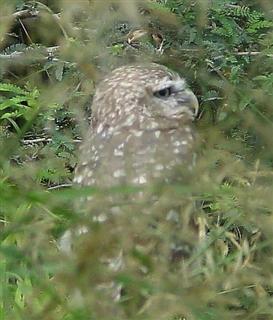Owl - burrowing
Scientific Name: Speotyto cunicularia
Fri, 1st November, 2024 - 10:28 am GMT
Sponsor Ads:

Alternative Name
Scientific Name: Speotyto cuniculariaBasic Info
By maturity, Burrowing Owls are usually eight inches (24 centimeters) in length with a 22 inch wingspan. These owls have short tails and long legs that allow them to run and walk with swiftness and ease. Usually, Burrowing Owls are brown and are spotted with white over their wings, backs, and heads. Their chests are often darker, though they are spotted with white also. Their white undersides show a pattern of brown barring. The eyes are yellow, as are the beaks. The faces of Burrowing Owls are whitish, but are accented with brown circular markings. Juvenile Burrowing Owls usually have buff colored underparts.
Health
Nesting boxes should be located on the ground, or a substrate that would allow burrowing should be provided, in order to allow the Burrowing Owl a more natural habitat. Burrowing Owls should be fed insects. Grasshoppers seem to be a special favorite. Some may also accept small reptiles or mice. Breeding Burrowing Owls lay their eggs in burrows lined with feathers or other soft materials. It is the male's job to thus prepare the burrow. The courtship ritual usually consists of short flight displays, the flashing of white markings, vocalizations, bowing, and nipping. Clutches consist of three to 12 eggs, though about eight would be average. The female Burrowing Owl will remain underground to incubate these eggs for three to four weeks. By the time the owlets are between six and seven weeks old, they will have learned to hunt for themselves.Habitat
N/ABehavior
Normally found in open prairies or grassy plains, the unique habits of the Burrowing Owl set it apart from other raptors. These owls do not use nests, but rather burrow underground. They may dig their own burrows, but more often they will take over abandoned dens dug by other animals like prairie dogs. Usually, the Burrowing Owl lines its home with vegetation or with feathers. It remains in this burrow during the day and also uses it to rear its young. Some live quite close together in a colony situation. During the night, Burrowing Owls hunt, flying into the air and swooping down on prey. Migratory birds, Burrowing Owls usually summer in northern North America, and winter further south. In the northern ranges where they customarily breed, Burrowing Owls are losing the habitats essential to the propagation of their species.Origin
North, Central, and South AmericaHistory
Burrowing Owls are found throughout North, Central, and South America, in different areas depending on the time of year. In many parts of this rather large range, Burrowing Owls are endangered. This is mostly due to the destruction of their habitats. Some have been poisoned by ingesting pesticide - ridden insects.Common Foods
Although most of its dietary needs are met with insects, Burrowing Owls have also been known to take lizards, mice, and small birds on occasion.Sponsor Ads:
Hunts Law of Suspense: If any work has a suspense date on it, that work will be completed as close to the suspense date as possible regardless of how far in advance it was programmed.
Owl - burrowing
Coded by: BGID® | ALL RIGHTS RESERVED Copyright © 2000-2024
Disclaimer | Privacy | Report Errors / Contact | Credits








 President of the United States of America - Real Estate mogul, Pageant owner and now one of the most controversial men in political history.
President of the United States of America - Real Estate mogul, Pageant owner and now one of the most controversial men in political history.  Politician, US Vice President and President of the USA - Joseph Robinette Biden Jr.
Politician, US Vice President and President of the USA - Joseph Robinette Biden Jr.  versus
versus  Russia: 'The Evil Empire'? Are they all that bad or is it just the USA trying to portray Russia as bad because they are a world power with land bigger and a society very different from the USA ideal?
Russia: 'The Evil Empire'? Are they all that bad or is it just the USA trying to portray Russia as bad because they are a world power with land bigger and a society very different from the USA ideal?  Global warming has been in and out as the "latest" hot topic for many years. It is, according to modern scientists, the result of man-made industrial pollutants, clearing forested areas, agriculture, etc. But now they are thinking it started way before the Industrial Revolution...
Global warming has been in and out as the "latest" hot topic for many years. It is, according to modern scientists, the result of man-made industrial pollutants, clearing forested areas, agriculture, etc. But now they are thinking it started way before the Industrial Revolution... 
 Corona virus
Corona virus 
 Users with wide screen monitors can benefit from more content on every page.
Users with wide screen monitors can benefit from more content on every page.